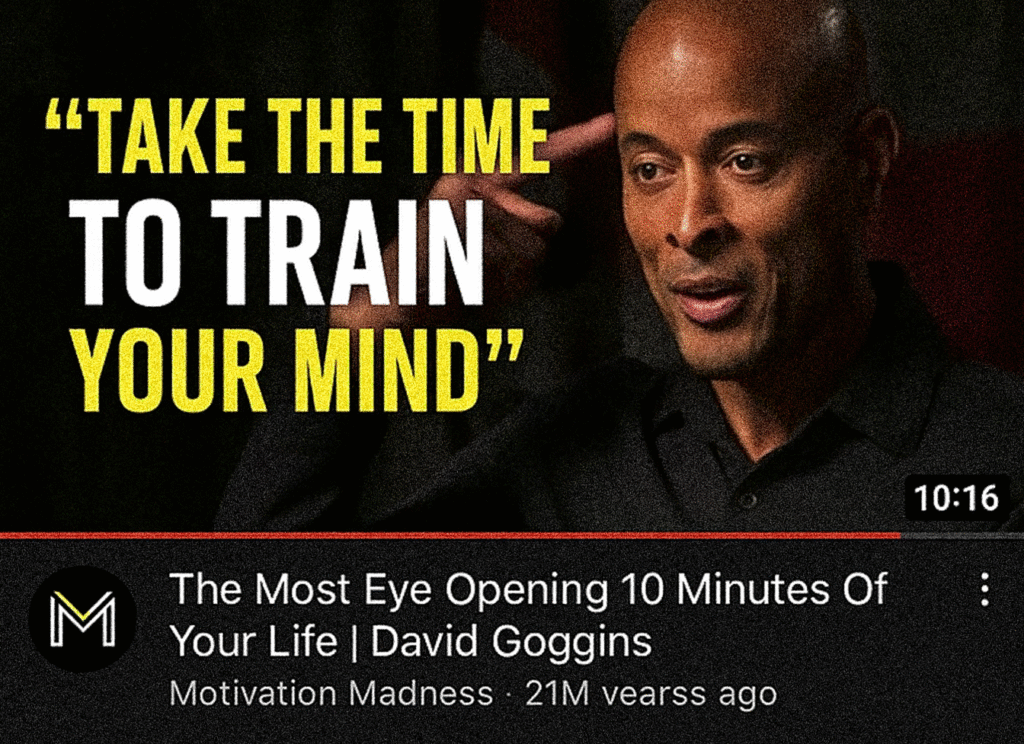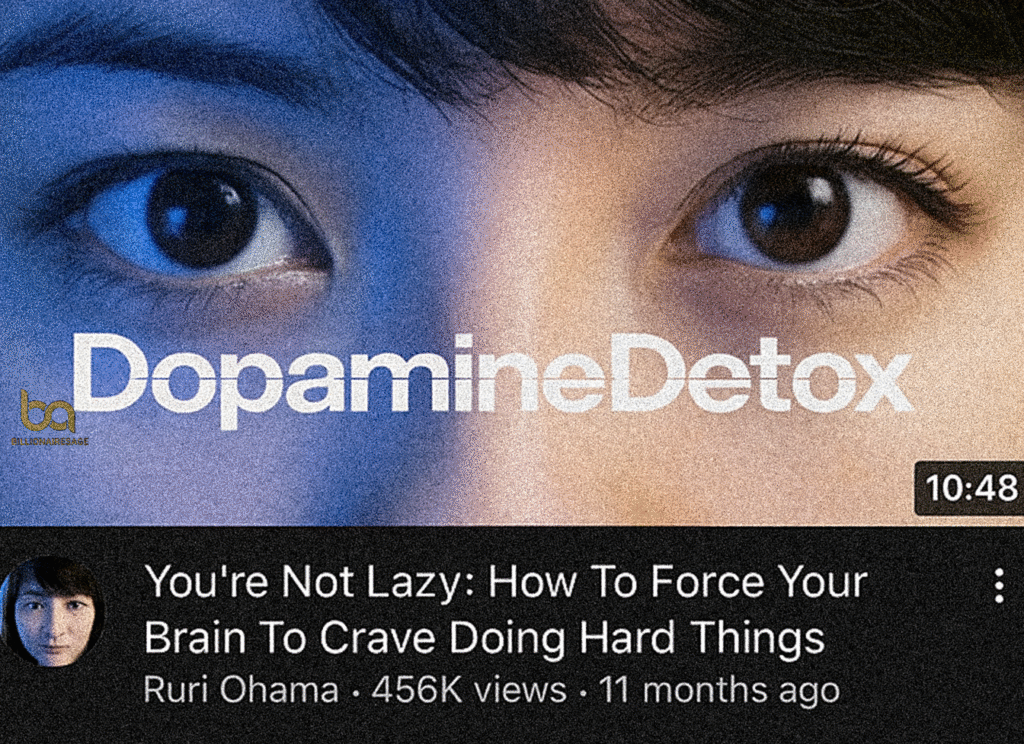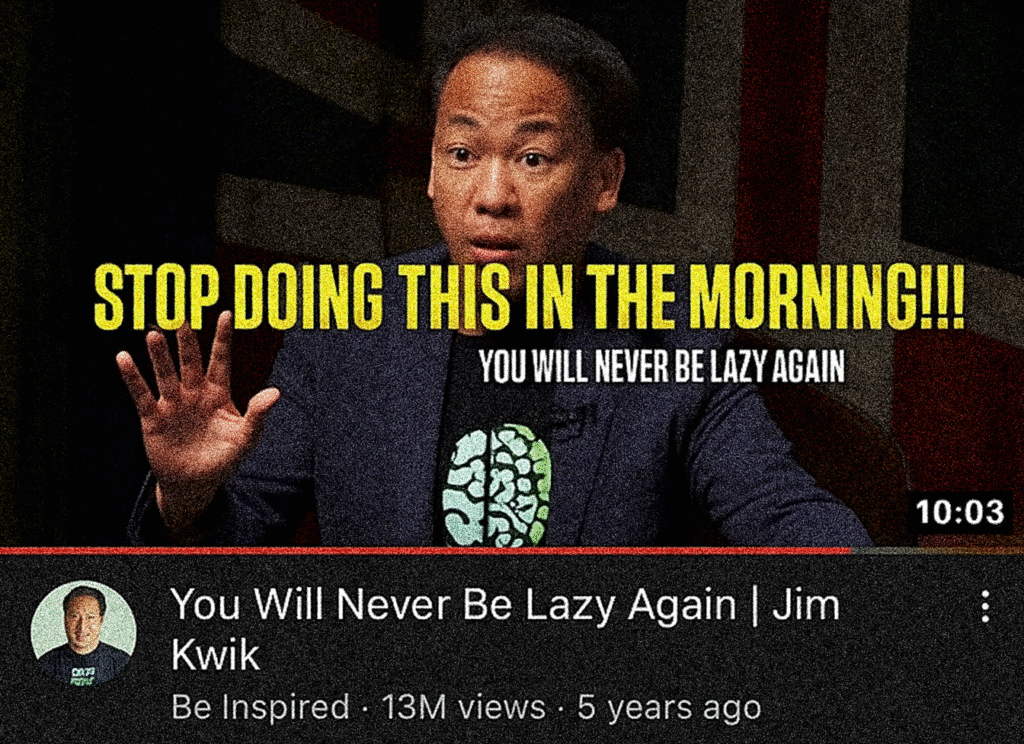In a world overflowing with motivational content, it’s easy to feel inspired for a moment—only to fall back into the same habits by the next day. The truth? Watching the right videos won’t change your life. But they can be the spark that lights the fire. The transformation comes afterward—when you turn inspiration into consistent action.
These 5 videos don’t just motivate you. They challenge the way you think. They rewire your mindset. They force you to look in the mirror and ask: “Am I living at my potential—or just watching others live theirs?
1. Justin Sung – How to Force Your Brain to Be Motivated (When You Don’t Feel Like It)
Justin breaks down the science of motivation like never before. In this video, he explains how to trick your brain into doing what you need to do, even when it’s the last thing you feel like doing. His insights helped thousands shift from 17% productivity to 97% performance—not by working harder, but by thinking smarter.
YouTube” – Link of the video

In this insightful video, Justin Sung delves into the psychology of motivation, emphasizing that relying solely on motivation is unreliable. Instead, he introduces a structured approach to cultivate consistent motivation through a method he calls DFUZ.
🔑 Key Concepts:
- Motivation-Enhanced vs. Motivation-Dependent: Sung distinguishes between being dependent on fleeting motivation and enhancing motivation through deliberate strategies.
- DFUZ Method:
- D – Distinguish: Separate feelings, thoughts, and actions to address each appropriately.
- F – Fake: Actively pretend to enjoy the task to build genuine motivation over time.
- U – Uptime: Gradually increase the duration of focused work sessions to build endurance.
- Z – Zone: Create a distraction-free environment to maintain focus.LinkedIn
- Intrinsic vs. Extrinsic Motivation: He explains that intrinsic motivation (driven by personal values) is more sustainable than extrinsic motivation (driven by external rewards).
- Neuroplasticity: By consistently applying the DFUZ method, one can rewire the brain to develop a habit of self-motivation.
Takeaway: Motivation isn’t about hype. It’s about strategy.
2. David Goggins – The Most Eye Opening 10 Minutes of Your Life
There’s no one like Goggins when it comes to mental toughness. He doesn’t sugarcoat anything. In just 10 minutes, he’ll shake your excuses and ignite something deep inside. His message? You don’t need to feel ready. You need to train your mind for the hard.🔑
YouTube – Link of the video

Key points
- Embracing Suffering: Goggins asserts that enduring pain and hardship is essential for personal development. By willingly facing adversity, individuals can discover their true potential.
- Mind Control: He highlights the importance of mastering one’s mind, stating that the brain can be both a powerful ally and a formidable adversary. Taking control of one’s thoughts is crucial to overcoming obstacles.
- Accountability: Goggins stresses the significance of holding oneself accountable. Recognizing personal shortcomings and taking responsibility for actions are steps toward self-improvement.
- Hard Work and Discipline: He underscores that success is not handed out but earned through relentless effort and unwavering discipline.
📌 Takeaway:
True transformation begins when you step outside your comfort zone, confront your fears, and take control of your mind. Embracing discomfort and holding yourself accountable are pivotal steps toward unlocking your full potential.
3. Ruri Ohama – You’re Not Lazy: How to Force Your Brain to Crave Doing Hard Things
Ruri explains how your environment and dopamine habits are quietly draining your drive. If you constantly feel stuck, this video is your mirror. She helps you reset your mind and build a system that wants to do difficult things.
YouTube – Link of the video

🔑 Key Concepts:
- Dopamine and Motivation: Ruri explains how our brain’s reward system, particularly dopamine, plays a crucial role in motivation. Overexposure to instant gratification activities (like scrolling through social media) can desensitize our brain’s response, making challenging tasks seem even more daunting.
- Environmental Design: She highlights the importance of structuring our environment to promote productivity. By minimizing distractions and creating spaces conducive to focus, we can make hard tasks more approachable.
- Identity and Self-Perception: Ruri discusses how labeling oneself as “lazy” can become a self-fulfilling prophecy. Instead, she encourages viewers to recognize that these behaviors are habits, not inherent traits, and can be changed with conscious effort.
- Building Systems: Rather than relying solely on willpower, Ruri advocates for the development of systems and routines that make engaging in hard tasks more automatic and less reliant on fleeting motivation.
📌 Takeaway:
Laziness isn’t an inherent flaw but often a byproduct of our environment and habits. By understanding the underlying mechanisms and restructuring our surroundings and routines, we can train our brains to embrace and even crave challenging tasks.
4. Jim Kwik – You Will Never Be Lazy Again
Jim Kwik is a learning expert, and his morning brain hacks can change your entire approach to discipline. In this video, he explains the damaging thing most people do first thing in the morning—and what to replace it with.
YouTube – Link of video

🔑 Key Concepts:
- Avoiding the Snooze Button: Kwik explains that hitting the snooze button can disrupt your sleep cycle and negatively impact your brain’s performance throughout the day.
- Hydration: Drinking water first thing in the morning is crucial, as the brain is composed of approximately 75% water. Proper hydration enhances cognitive function and energy levels.
- Brain-Boosting Activities: Engaging in activities like meditation, journaling, and setting clear intentions can prime the brain for productivity and focus.
- Physical Movement: Incorporating exercise into your morning routine increases blood flow to the brain, enhancing mental clarity and reducing feelings of laziness.
- Continuous Learning: Kwik emphasizes the importance of lifelong learning and suggests dedicating time each morning to read or acquire new knowledge.
📌 Takeaway:
Small, intentional changes in your morning routine can have a profound impact on your productivity and motivation levels. By implementing these strategies, you can train your brain to overcome laziness and achieve your goals more effectively.
5. Rian Doris – How to Force Your Brain to Crave Doing Hard Things
Rian outlines the 4 triggers your brain needs to enter flow and peak performance: Purpose, Curiosity, Autonomy, and Mastery. If you build a life around these, hard things stop feeling like chores—and start feeling like growth.
YouTube – Video link in bio

🔑 Key Concepts:
- Intrinsic vs. Extrinsic Motivation: Doris explains that intrinsic motivation—driven by internal desires like curiosity and purpose—is more sustainable and effective than extrinsic motivation, which relies on external rewards such as money or praise.
- The Five Intrinsic Motivators:
- Curiosity: Engaging in tasks that pique interest can activate the brain’s reward system, releasing dopamine and enhancing focus.
- Purpose: Connecting work to a larger mission or goal increases persistence and satisfaction.
- Autonomy: Having control over one’s work fosters a sense of ownership and responsibility.
- Mastery: The drive to improve and excel in a particular area encourages continuous learning and development.
- Autotelicity: Finding inherent enjoyment in tasks makes the work itself rewarding, independent of external outcomes.
- Flow State: By harnessing these intrinsic motivators, individuals can enter a state of flow—a mental state characterized by deep focus and immersion in activities—leading to enhanced productivity and fulfillment.
- Practical Application: Doris suggests assessing and nurturing each intrinsic motivator to boost overall motivation. For instance, setting goals that align with personal values can enhance purpose, while seeking tasks that challenge existing skills can promote mastery.
📌 Takeaway:
By focusing on intrinsic motivators, individuals can rewire their brains to not only tackle challenging tasks but to find genuine satisfaction in them. This shift from external to internal motivation can lead to sustained productivity and personal growth.
Final Thoughts
These videos are more than content—they’re tools. But only if you act on them. Don’t just watch. Rewatch. Take notes. Reflect. Apply.
Because it’s not what you learn in the moment— it’s what you live every day that defines who you become.
Turn inspiration into transformation. Save this list. Start today.
